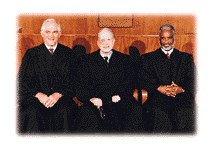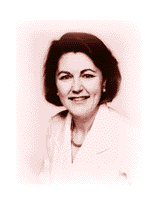Tigers in the court

Class Notes - March 10, 1999
Class notes features
Shown (from left) are James Robertson '59, Oliver Gasch '28, and Henry H. Kennedy, Jr. '70, each of whom is a United States District Judge for the District of Columbia. Gasch has been serving since 1965 and was appointed by President Johnson. President Clinton appointed Robertson in 1994 and Kennedy in 1997.
Where educating all children is the
goal
Learning differences are no barrier for Ed Cervone '55
The common model of education, says Edmund Cervone '55, is "a 100-sum game. Fifty-nine percent is failure; an additional 11 percent is still unacceptable; only the top 20 percent is success. The lesson it teaches is that you must avoid errors." Under such a model, he points out, if there were an examination consisting of four essay questions, and you wrote only three answers, you would receive a 75, a C -- even if for your three answers you had composed the Declaration of Independence, the Gettysburg Address, and Magna Carta. "Too often," he says, "we leave no room for creativity and for excellence; we are focusing merely on touching all the bases."
As the national media are turning their attention to what is considered a crisis in education today, Cervone continues to examine what has been his lifelong passion: how can we educate the many people who do not learn in traditional ways, and what can we all learn about education in the process?
Cervone, a graduate of Trenton High School who spent a postgraduate year at the Hun School of Princeton, includes that school's founder, John Hun, with Princeton's legendary President James McCosh and longtime Deerfield Academy headmaster Frank Boyden as exponents of the essential idea of education: "You must succeed in teaching. Failures are not options."
After graduating from Princeton and working in the business world for a few years, Cervone began to teach reading. He noticed that, regardless of what school he was in, he was seeing some students who had fundamental problems of language processing; in every other way, however, those students were essentially similar to other students. Another observation was disturbing: too often, teachers, "through quips, body language, or sarcasm," were persecuting those students who did not learn in the traditional way.
While pursuing graduate work in reading and language processing at Temple University, where he earned his doctorate in 1974, Cervone continued to be involved in reading programs in schools and had a private practice. He saw students who were being separated from the rest of the population in public schools because the prevailing attitude was that they could not be successful unless they learned in the same way as did students in the mainstream. These students were being denied access to traditional courses, he says, and they recognized the social implications of being on a secondary track.
Perceiving an unmet need, Cervone approached the headmaster of the Pennington School, an independent school in Pennington, New Jersey, and proposed establishing what would become in 1975 the Center for Learning, a highly regarded -- and often imitated -- program for students with learning differences, functioning within the school's college preparatory curriculum. Cervone served as director of Pennington's Center for Learning until he retired last June.
Having discovered that many successful non-traditional learners (e.g., Thomas Edison and General George Patton) eventually were educated at home, Cervone realized that "the involvement of people who loved them and would not give up on them was critical to their success." Firm in his belief that "you can educate learning-different people without apology and in the mainstream," he determined, as a basic principle of the program he founded, "to put intelligent, good people in contact with students and, rather than focusing on what students cannot do, build incrementally on what they can do."
Today, Cervone is gathering his ideas and working to develop a number of ways to involve more people -- parents, especially -- in education. "I really do believe that 'it takes a village to raise a child.'" he says. "We need to involve more of the community in education, not just teachers." He believes passionately that the pedagogy he has advocated for learning-different students is necessary for all students -- "We have to take all students where they are and move them ahead" -- but he emphasizes that he is not focusing on technique: "We're not talking about recipes here; we're talking about attitudes."
-- A. Melissa Kiser '75
"I work for nature by investigating and interpreting the history of our engagement with it. On the basis of what I learn, I also can't resist the impulse to issue pronouncements on where we ought to head from here." So says Phil Terrie '70, whose "office" when working for nature is the Adirondack Mountains of upstate New York, where he has spent every summer since 1966.
More than just a "summer person," Terrie has combined his deep affection for the region with an ongoing study of the interrelationship between the public environmental concerns of conservationists and the private economic concerns of the local people of the Adirondacks. Terrie's work, which has resulted in three books and more than 40 articles, gives his understanding a scope and his advocacy a balance that few others have attained. Some of his pronouncements have not endeared him to his summer neighbors: he was once roundly booed at a public meeting when he spoke up in favor of state-mandated controls on private property. Nevertheless, his efforts to address protection for the land while still "getting the local voice into the narrative" have earned him a reputation with the curators at the Adirondack Museum as "the ultimate Adirondack historian." And noted naturalist Bill McKibben, writing in the New York Review of Books, called Terrie's most recent book, Contested Terrain: A New History of Nature and People in the Adirondacks, "the finest general Adirondack history yet written, the book to which all subsequent accounts will have to refer."
Terrie's first introduction to what has become the love of his life resembles a lucky blind date. With no summer job after his senior year in high school and no desire to return to his hometown of Charleston, West Virginia, Terrie took off for Long Lake, New York, on a teacher's last-minute suggestion. There he became a counselor at the Adirondack Wilderness Camp, in the center of the Adirondack State Park. The wilderness unexpectedly "spoke to the deep corners of my soul. I was 18 years old, a confirmed atheist, graduating from an Episcopal boarding school. It was a good time to become passionate."
Now a professor at Bowling Green State University, in Ohio, and director of American Culture Studies there, Terrie before the start of each fall semester leaves his heart in his own piece of the Adirondacks. Purchased in 1979, these 26 acres of woods slope back from a steep, rocky bank of Long Lake. The original small cabin has grown to accommodate family and friends, but there is still no electricity, and the only access is by a six-mile boat ride. Each year Terrie's main visit begins on July 1 and lasts until late August, when he drives away from the village dock with just enough time to make it back for his first faculty meeting.
A typical Terrie day on Long Lake begins on the deck with bagels and two hours of bird watching. Just before lunch it's a ride on his mountain bike over a stretch of the Northville-Lake Placid Trail; after lunch, it's a nap. Following a late-afternoon game of volleyball on the other side of the lake, he may join friends for cocktails and dinner before heading back across the water for an early bedtime. Terrie breaks up this grueling schedule with research in local archives for his next book, or investigating the feasibility of an environmental museum in Tupper Lake, or bushwhacking up Blueberry Mountain, or running meetings as president of the Cold River chapter of the Adirondack Mountain Club.
He admits that he doesn't get much writing done during the summer: "I need a less attractive place to work -- like Bowling Green."
-- Kathy Taylor '74
Endowing prizes for Irish youngsters
 What inspires philanthropy? "You try to pass on what you've had,"
says writer and philanthropist Genevieve Muinzer '75. "People have
been very kind to me. You try to repay your debt."
What inspires philanthropy? "You try to pass on what you've had,"
says writer and philanthropist Genevieve Muinzer '75. "People have
been very kind to me. You try to repay your debt."
This philosophy has prompted Muinzer, an American raised in Belfast, to share her time and money -- even when she hasn't had much of either. In 1983 Muinzer, just out of graduate school and earning less than £4,000 a year working at a law firm, launched an Irish literary prize -- the Lady Gregory Award. Muinzer, an American raised in Belfast, says she got the inspiration for the prize from Princeton.
"When I was at Princeton I saw all the wonderful scholarships that were on offer. I got a financial aid scholarship. My sister (Philomena '77) won creative writing prizes." This American model of philanthropy was different from what Muinzer had observed in Europe, where education and the arts are funded by the state, not individuals. "I saw how much individuals helped one another," she says. "So when I finished Princeton I realized what a debt I had to my school in Ireland and to Irish writers who have made such a huge contribution to English literature."
The award is named after 19th-century Anglo-Irish literary patroness Lady Gregory. Lady Gregory was a founder of the Abbey Theater in Dublin and patroness to Yeats and other major Irish writers. "She was a great promoter of Irish literature at a time when it was deeply unfashionable and considered the language of peasants," explains Muinzer. "She gave it a respectability."
The Lady Gregory Award is open to students ages 11 to 18 in Northern Ireland. Muinzer reads all the finalists' manuscripts herself -- over 200 short stories. Students compete fiercely for the prize. "There haven't been a lot of opportunities for young people in Northern Ireland," says Muinzer, "particularly during the troubles."
Civil unrest in Northern Ireland inspired Muinzer to set up a second award -- a mathematics prize for girls in impoverished Derry. "Many people on both sides of the religious divide had been interned, and so couldn't get jobs," explains Muinzer. "It was incumbent on very young girls to leave school and get jobs to support their families." When a friend set up numeracy centers to help the girls get the best jobs possible, Muinzer located a benefactor who funded the centers and prize. The prize -- named after Muinzer -- is given every year to the girl who has made the most original contribution to the study of mathematics. The prize's name is ironic, laughs Muinzer, "because I probably got the lowest math SAT score in the history of Princeton admissions!"
Helping others has also been a theme in Muinzer's writing. As an American who's spent much of her life abroad (she lives with her British husband and five-year-old son in London), she's experienced displacement. Her 1986 book, New to the UK: A Guide To Your Life and Rights, helps foreigners understand legal and social obstacles they're likely to encounter in Britain. "As a foreigner you never quite fit in," says Muinzer. "A lot of people get very isolated and depressed. I tried to look at the positive things you can bring to another country as a foreigner."
Though Muinzer has given up writing largely because of a liver infection she had, she continues practicing and encouraging American-style philanthropy in England today as a governor of the Marymount School and a member of the British Asthma Council and the Oxford University Law Foundation.
-- Tamsin Todd '92
GO TO the Table of Contents of the current issue
GO TO PAW's
home page